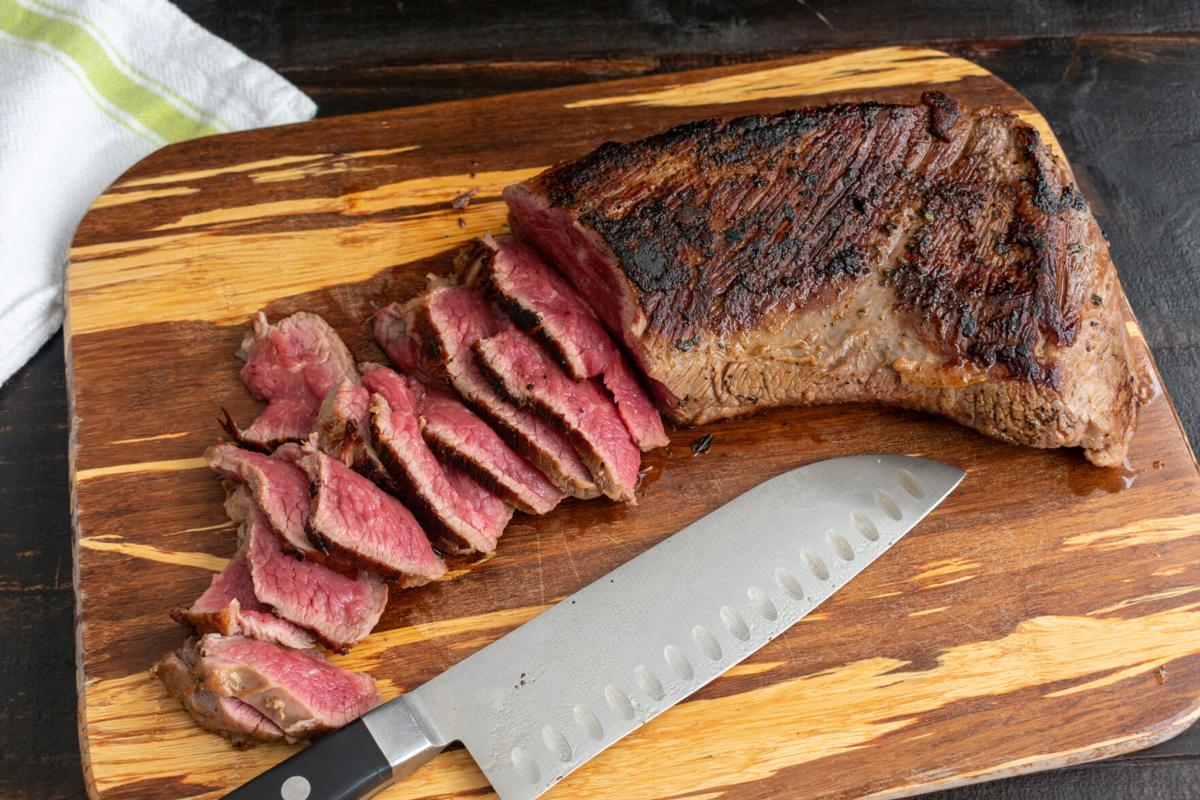Tri-tip roasts were on sale at my favorite meat market last week on a buy-one-get-one special, and who could say no to that?
The thing is, I confess that I’ve never cooked a tri-tip. They weren’t even offered at markets in Detroit or Chicago when I lived in those two cities, so what I knew about them was that they were a popular grilling cut on the West Coast. I had a mental note that there was a trick about tri-tips, but I couldn’t remember precisely what it was.
I checked in with my friend Bev, herself a retired food writer. I asked her if she’d ever grilled a tri-tip, expecting her to weigh in with the expertise that I lacked. Instead, she said no — that she always put them in the slow cooker.
Well, now. Here was my chance to learn which way I preferred.
Tri-tips are a cut from the sirloin sub-primal, and until recently, butchers tossed them on the pile of scraps they used for ground beef. But these days, they’re common enough, and their position at the bottom of the sirloin means that they contain muscle that hasn’t been used very hard — the traditional hallmark of a tender steak.
The trick I couldn’t remember, as it turns out, is that tri-tip has grain that runs in two directions. The triangular end’s grain runs east-west, as it were, while the remaining large cut’s grain runs north-south. Therefore, as with flank steak, you want to cut it on the bias, with the knife blade angled at about 20 degrees, across the grain to make the most succulent slices.
It’s a good idea to study the raw roast, and you’ll see precisely where the grain changes. Some grillers like to cut the roast into two pieces at that point, but as I have confessed earlier, I am a lazy cook.
I barbecued the first tri-tip, rubbed with a coffee-chile, cowboy kind of rub. First I smoked it at a very low temperature for about two hours, then I hiked the heat to finish the roast to 125 degrees internal temperature for the rare beef I love.
It was fabulous — smokey, slightly chewy, and full of beef flavor. It reminded me of a flank steak grilled the same way.
I put the second roast with the same coffee-chile rub into the slow-cooker a couple of days later, following Bev’s advice for temperature and timing. This gave me a totally different result — a flavorful roast that shredded easily with a couple of forks or, as I prefer to do it, in a stand mixer fitted with the mixing blade.
The pile of shredded beef was delicious on its own, over mashed potatoes with some of its cooking juices spooned over. There was still plenty left the next day, so I moistened the leftovers with some of my favorite barbecue sauce and had it as a filling for sandwiches. This would also be good in burritos, quesadillas or tacos, I thought.
Both ways were good, one not superior to the other. But now I knew what to do the next time tri-tips were on sale.
2-way coffee-chile rubbed tri-tip
Makes about 4 to 6 servings
A tri-tip roast is superb when grilled, and shreds easily when slow-cooked to make a terrific filling for tacos or burritos. Remember the trick about carving grilled tri-tip: The grain runs one way in the triangular end, and the other way in the squarish segment that’s left. Carve into thin slices across the grain in each end. If you can, angle the knife blade about 20 degrees to cut on the bias.
Ingredients
2 tablespoons instant coffee granules
2 tablespoons chipotle chile powder
2 tablespoons granulated sugar
1 tablespoon kosher salt
2 teaspoons coarsely ground black pepper
1½- to 2-pound tri-tip roast
Preparation
Combine the coffee granules, chipotle chile powder, sugar, salt and black pepper in a small bowl.
Rub the seasonings all over the tri-trip roast, being sure to liberally cover all sides. If you’re grilling, set the roast aside at room temperature for two hours. When you’re ready to cook, place the tri-tip on a well-oiled grate over a medium hot fire.
Cook for about 15 minutes to a side, checking the internal temperature. Remove the roast from the grill when the internal temperature reaches: 125 for rare, 130 for medium rare or 135 for medium.
Allow the roast to rest for 15 minutes before carving.
If you’re going to slow cook the tri-tip, wrap it snugly with foil, sealing the edges carefully, and place into a slow cooker set to high.
Cook for 5 hours. Remove from the slow-cooker and set on a wooden cutting board to cool. When it’s cool enough to work with, open the foil and transfer the roast and its juices to a large bowl. Shred with two forks or a stand mixer fitted with the mixing paddle.
Serve warm as a filling for tacos or burritos or moisten with your favorite barbecue sauce for barbecued beef sandwiches.





